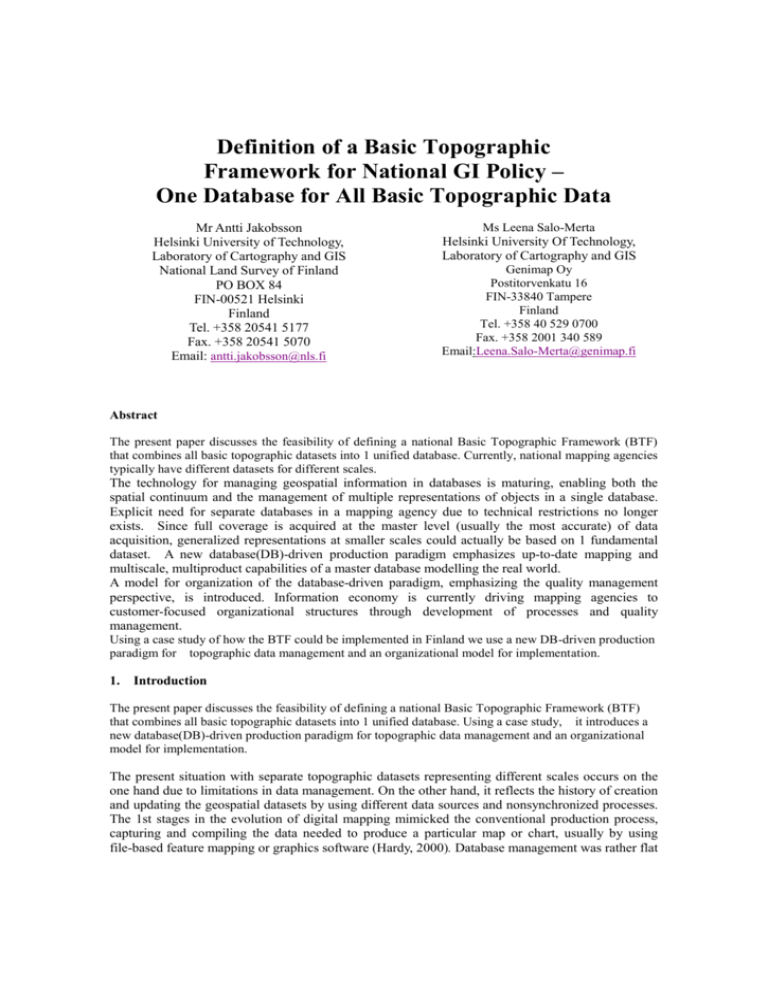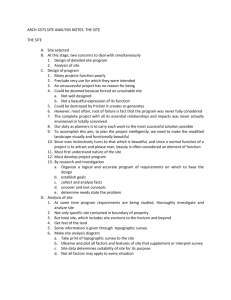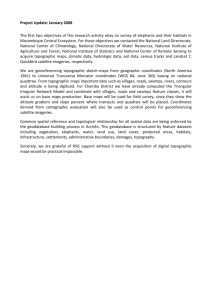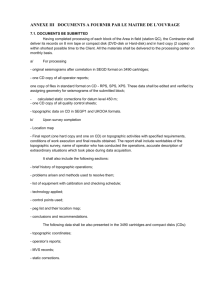Definition of a Basic Topographic
advertisement

Definition of a Basic Topographic Framework for National GI Policy – One Database for All Basic Topographic Data Mr Antti Jakobsson Helsinki University of Technology, Laboratory of Cartography and GIS National Land Survey of Finland PO BOX 84 FIN-00521 Helsinki Finland Tel. +358 20541 5177 Fax. +358 20541 5070 Email: antti.jakobsson@nls.fi Ms Leena Salo-Merta Helsinki University Of Technology, Laboratory of Cartography and GIS Genimap Oy Postitorvenkatu 16 FIN-33840 Tampere Finland Tel. +358 40 529 0700 Fax. +358 2001 340 589 Email:Leena.Salo-Merta@genimap.fi Abstract The present paper discusses the feasibility of defining a national Basic Topographic Framework (BTF) that combines all basic topographic datasets into 1 unified database. Currently, national mapping agencies typically have different datasets for different scales. The technology for managing geospatial information in databases is maturing, enabling both the spatial continuum and the management of multiple representations of objects in a single database. Explicit need for separate databases in a mapping agency due to technical restrictions no longer exists. Since full coverage is acquired at the master level (usually the most accurate) of data acquisition, generalized representations at smaller scales could actually be based on 1 fundamental dataset. A new database(DB)-driven production paradigm emphasizes up-to-date mapping and multiscale, multiproduct capabilities of a master database modelling the real world. A model for organization of the database-driven paradigm, emphasizing the quality management perspective, is introduced. Information economy is currently driving mapping agencies to customer-focused organizational structures through development of processes and quality management. Using a case study of how the BTF could be implemented in Finland we use a new DB-driven production paradigm for topographic data management and an organizational model for implementation. 1. Introduction The present paper discusses the feasibility of defining a national Basic Topographic Framework (BTF) that combines all basic topographic datasets into 1 unified database. Using a case study, it introduces a new database(DB)-driven production paradigm for topographic data management and an organizational model for implementation. The present situation with separate topographic datasets representing different scales occurs on the one hand due to limitations in data management. On the other hand, it reflects the history of creation and updating the geospatial datasets by using different data sources and nonsynchronized processes. The 1st stages in the evolution of digital mapping mimicked the conventional production process, capturing and compiling the data needed to produce a particular map or chart, usually by using file-based feature mapping or graphics software (Hardy, 2000). Database management was rather flat when considering the (semantics of) geographical features, even when based on 1 so-called source database. One dataset might be copied and compiled into several independent branches to create new products or to support different functions in the organization. The connection to the original source was lost, and propagating the updates became a problem. A new DB-driven production paradigm emphasizes up-to-date mapping and the multiscale, multiproduct capabilities of a master database modelling the real world. A model for organization of the DB-driven paradigm, emphasizing the quality management perspective, is introduced. The information economy is currently driving mapping agencies to customer-focused organizational structures through development of processes and quality management. 2. The new feasibilities of motivating for change 2.1. Technical advances in spatial data management The technology for managing geospatial information in databases is maturing, enabling spatial continuum and reasonable performance in very large databases. Solutions for managing long transactions and distribution are provided, and attempts to manage different scales and multiple representations of objects in a single database have also been made. Future explicit need for separate databases in a mapping agency is not self-evident due to technical restrictions. Since full coverage is attained at the master level (usually the most accurate) of data acquisition, generalized representations at smaller scales could actually be based on 1 fundamental dataset. Object-orientation (OO) is currently joining the mainstream of GIS (Geographic information System). We can mention 3 commercial database management systems (DBMSs) that apply OO in different ways: Laser-Scan’s Gothic (Laser-Scan, 2001) uses an object-oriented database, GE Smallworld (GE Smallworld, 2001) uses a relational database termed The Version Managed Data Store (VMDS) combined with an object-oriented application programming language, and Oracle (Oracle, 2001) uses an object-relational database with an abstract datatype for spatial data (Oracle Spatial). In the following we refer to some interesting concepts that support the DB-driven production paradigm. They are connected with Laser-Scan, which has been active in developing advanced solutions that support mapping and map production. The active object technique means that database objects are not only data structures with static data, but can use methods that perform operations (programmed functions). Methods can be assigned to certain database events, and as a result activation of the operations is invoked by the DBMS. This can be considered to be a powerful tool for tailoring the functionality of the DBMS. The database objects become intelligent and ‘know how they should behave’. (Hardy, 1999, 2000) Databases that store several simultaneous representations for a geographical feature are called multiple representation databases (e.g. Kilpeläinen, 1997). These representations can be alternative geometries to be used in different contexts, e.g. generalizations for different scales or an object’s ‘special editions’ for a certain map product. Object views define in which context a certain representation of an object is meant to be used (Hardy, 1999, 2000) Generalization of geographic features has remained a problem, because the automation of generalization has mostly been straightforward and concentrated on processing single objects at a time. However, the way the object should be treated to gain a favourable cartographic result is dependent on its environment as well. Multi-agent generalization brings a new and promising approach to the generalization of objects within their context (AGENT project, Lamy et al. 1999). Agents are self-aware software components that co-operate, subject to a set of constraints, to achieve a goal. Applied to map generalization, the geographic objects such as roads and houses, become active agents and cooperate through generalization operations to achieve a cartographically acceptable result (Hardy, 2000). 2.2 Organizational change – from national mapping agencies to spatial data managers and providers? National mapping agencies were established between the 18th and 19th centuries when technical inventions enabled, and national interest demanded, accurate maps to cover the entire country. The military and government needed topographic maps. In the 21st century nearly all mapping agencies currently have digital maps based on traditional topographic mapping processes. Now customers’ needs are changing the role of mapping agencies. Morrison (1997) call this a ‘democratization’ of cartography. There are several different approaches that mapping agencies have chosen. In Great Britain the Ordnance Survey (OS) is acting more like a private company receiving all of its revenues from the market. Its vision is: “Ordnance Survey and its partners will be the content provider of choice for location-based information in the new information economy” (Shiell, 2001). Several countries have selected the subscriber-producer model, in which the government agency acts as the subscriber and private companies the producer. Examples of this are found in Denmark, Estonia and Slovenia. Some countries have also focused their production on some areas, features or themes. Land Information New Zealand (LINZ) has focused its interests on database production (Howard, Mole, Pickering, Woodsford, 1999). In the USA, the future role of the National Mapping Division of the USGS might be in promoting standards to help integrate locally collected ‘large-scale’ data from which ‘smaller-scale’ maps of portions or the whole of the nation could be created (Tosta, 1997). This introduces the integrator role for NMA, in which the NMA combines data from different producers (private or public). The main focus for mapping agencies in the new information economy could be as a manager and provider of basic topographic information for several different uses. This means that a mapping agency must develop a strategy for its data production processes, database management, quality management, data delivery processes and business processes. 2.3 Challenges for the information economy and customers Technology will again play an important role in meeting the new demands. The Internet has connected data providers and customers. Location-based services using the Global Positioning System (GPS) and mobile technology will need new data products and better quality. Standardization in geographic information (GI) (ISO 19100 series, Open GIS specifications) is opening a global market for data providers and customers. Again these changes will mean great challenges for data providers especially in training of personnel, and process and quality management. Customers will require new real-world-based information products. A traditional topographic map will no longer meet the requirements. Topographic data must cover large areas (country, regions, continents), quality and other metadata information must be made available and updates are coming from several sources requiring object-based data management. In the data delivery process data must be available on the Internet. 2.4 Spatial Data Infrastructures At the national level, common spatial data are defined through community and/or national agreements on content. They are known as ‘framework’ data in the United States and ‘fundamental’ data within the Australian Spatial Data Infrastructure (ASDI). The framework is a collaborative effort to create a common source of basic geographic data. It provides the most common data themes geographic data users need, as well as an environment to support the development and use of these data. Examples of such initiatives are: Australian Spatial Data Infrastructure Fundamental Data, U.S. Federal Geographic Data Committee’s Framework and Global Mapping Specifications (GSDI, 2000). The Global Spatial Data Infrastructure (GSDI) community believes that a GSDI backed by international standards, guidelines and policies on access to the data is needed to support global economic growth and its social and environmental objectives. 2.5 Standardization During the 1990s standardization of GI was initiated in Europe. The results were published as prestandards in 1996. At the same time the International Organization for Standardization (ISO) began its operations. The ISO 19100 series now has over 20 standards for GI and the number is increasing. The Open GIS Consortium, Inc. (OGC) is a not-for-profit membership organization founded in 1994 to address the lack of interoperability among systems that process georeferenced data, and between these systems and mainstream computing systems. It has developed several specifications. Examples include: Geography Markup Language (GML) Implementation Specification. GML is an Extensible Markup Language (XML) encoding for the transport and storage of GI, including both the spatial and nonspatial properties of geographic features. Web Map Server Interfaces Implementation Specification enables users to combine map layers from different producers on the web. Standardization will remove major technical problems that currently have inhibited the combination of different datasets. Still some problems remain: What is the real-world object that a feature is trying to represent (modelling) and what is the quality of the product and is it accurate enough? (user’s data quality). 3. Spatial data manager and provider model for the DB-driven paradigm A national GI policy should define processes and data products that are used to produce topographic data. Quality management plays an important role when data are collected or compiled to datasets and products. There are several different identifiable roles in a process: data producer, data manager and provider, (value-add) reseller/producer and data user. Traditionally, the entire process has been managed by a national mapping agency. The need for documentation has been low, and process control has been based on tradition and good workmanship. Customers, on the other hand, have not had the necessary control over products, and compiling different data products has been difficult. A model in which data production (and revision) and data management have been separated provides new possibilities. In the model, data transfers use defined standard protocols (e.g. XML, GML). Data specification is available for users and data producers. The data manager has the responsibility for data quality. The model open ups opportunities to the information economy: The data user can be a data producer, and different data producers can be used for various features and process phases (e.g. revision). Data producer 1 Data manager and provider Data producer 2 Value-add reseller/ producer Partner Data user Quality management plays an essentialQuality role inmanagement the model. The data manager and provider have the main responsibility for quality. Data specification also plays a very important role. A case study will explain how a data manager and provider model could be implemented using a Figure 1. Data manager and provider model DB-driven paradigm. 4. Case study – a Basic Topographic Framework for Finland The key issues in a BTF approach are the modelling of the basic topographic data and the reorganization of the database revision process. This case study will define a new model for the basic topographic data using a DB-driven paradigm and provide an example of how this paradigm could be implemented with the data manager and provider model. 4.1 Modelling of the BTF – the real world as a target The BTF will have the most accurate data available for an area, theme or object type. The accuracy level is dependent on user needs. Thus, urban areas can be more accurate than rural areas, for example. The database can have different object views defined for different scales, products or users. An object can share properties with objects in other views. Updating of the BTF can be performed separately for each object view if necessary. Nevertheless, when the master level of the BTF is updated all object views will be updated as well. Each object will have a unique identifier, which enables updates from different sources to be accepted. © Geodata Oy © Maanmittauslaitos The Basic Map (raster) © Vantaan kaupunki The BTF Municipality: Urban area Figure 2 The Basic Topographic 1:250 000 Road data from private industry Framework with object views The positional accuracy of the BTF is defined by the most accurate dataset. This dataset can be comprised of certain areas (e.g. urban area) or themes (e.g. roads). The BTF should be accurate enough so that inadvertent errors are avoided when different datasets are combined. Revision of the BTF can be based on object views if the most accurate dataset is not updated as frequently. However, when the most accurate dataset is updated all object views are updated as well. The relationship between the most accurate geometry and object views is defined. The objective is that this relationship is automatic when using generalization algorithms and digital identifiers, but a manual relationship is also possible. The revision and data delivery processes uses object-based data management. Each object has a digital identifier. Revision can be performed whenever an object is changed. This information can come from the data user as well. 4.2 Organization of BTF maintenance European Union Regional datasets The National Land Survey Small-scale datasets Ministry of Agriculture and Forestry Municipalities Urban areas Data manager and provider: The BTF The Population Register Centre: Buldings, attributes information Customers Data producer Value-add producer The Finnish Road Administration Digiroad Figure 3. The BTF and different participants Organization of the BTF is based on the spatial data manager and provider model explained earlier. Different organizations can participate in several roles simultaneously. Data production and revision can be executed in a distributed manner with several different data producers. For example, the Population Register Centre’s attribute information on buildings can be linked with the BTF geometry. The municipalities’ urban area datasets would be part of the BTF. Revision in these areas would also be more accurate and more frequent than in the other areas. The proposed model would not change the present organizations responsibilities. Each present data producer could update and manage its own dataset. Data would be linked with the BTF database. 5. Discussion The case study uses topographic data as an example where a new DB-driven production paradigm and spatial data manager and provider model could be used. In Finland the new cadastral system (UKTJ) has some of the characteristics of the proposed model. The municipalities will act as producers of their areas for the new cadastral system. In general, the proposed model could also be used for other GI or in multi-national co-operation. Spatial data manager and provider model together with DB-driven production paradigm could be part of a national SDI. The difference between the proposed model and current SDIs is the quality management perspective together with the DB-driven production paradigm. Examples of similar initiatives include The OS’s Digital National Framework and the Amtliches Topographisch-Kartographisches Informationssystem (ATKIS) model in Germany. The Digital National Framework will provide a consistent and maintained national base against which GI can be referenced through the National Grid or unique identifiers. The identifiers are given to real-world features such as buildings, roads and land parcels. It means re-engineering the National Topographic Database over the next 2 years (OS, 2000). 5.1 Benefits of the proposed model The information society will benefit when all the data compiled by the different producers can be used in the BTF. The data manager will define the required accuracy level. Currently, data producers decide for themselves and are responsible for quality, which can mean that some datasets can not be combined. Customers will receive frequent updates and can combine attribute information with the BTF datasets. 6. Authors' contributions The main author is Mr. Antti Jakobsson who is employed by the National Land Survey of Finland (NLS) and was a chief developer of the Topographic Database System in 1992. Currently, he is working with the quality management issues in the NLS. He is a postgraduate student in the Helsinki University of Technology and is preparing a doctoral thesis. Ms. Leena Salo-Merta, who was employed by the NLS during 1990-2000 and was the designer of the topographic database for the Smallworld system, wrote Chapter 2.1 and assisted the preparation of Chapter 1. References: ANZLIC, the Spatial Information Council, Australian Spatial Data Infrastructure Fundamental Data http://www.auslig.gov.au/asdi/index.htm. GE SmallWorld, 2001, http://www.gesmallworld.com/. GSDI , 2000, Developing Spatial Infrastructures: The SDI Cookbook ver. 1.0, http://www.gsdi.org/. Hardy, P.G., 1999, Active Object Techniques for the Production of Multiple Map and Geodata Products from a Spatial Database, In ICA/ACI Conference Proceedings, August 1999, Ottawa, Canada Hardy, P.G., 2000, Map production from an active Object Database using Dynamic Representation and Automated Generalisation, http://www.laserscan.com/. Hardy, P.G., 2000b, Multi-Scale Database Generalisation for Topographic Mapping, Hydrography and Web-Mapping, Using Active Object Techniques, IAPRS, Vol. XXXIII, Amsterdam 2000. Howard G., Mole D., Pickering R., Woodsford P,, 1999, A National Topographic Database for the 21st Century –Paradigm Shifts in Business Process and Technology, http://www.laserscan.com/ . International Steering Committee for Global Map, Global Mapping Specifications - Version 1.0, 20 November 1998 http://www.auslig.gov.au/mapping/global_m/specv1_0.htm. Kilpeläinen, T., 1997, Multiple Representation and Generalisation of Geo-Databases for Topographic Maps, Doctorate thesis, Publication of the Finnish Geodetic Institute, No. 124. Lamy, S., Demazeau, Y., Jackson, M., Mackanness, W. A., Weibel, R., 1999, The Application of Agents in Automated Map Generalisation. In ICA/ACI Conference Proceedings, August 1999, Ottawa, Canada. Laser-Scan, 2001, http://www.laserscan.com/ Morrison, J.L., 1997, Topographic mapping in the twenty-first century. In Framework for the World, 1997, GeoInformation International, Cambridge, pp. 14-27. Open GIS consortium 2001, http://www.opengis.net/gml/01-029/GML2.html. Oracle, 2001, http://www.oracle.com/ OS, 2000, Digital National Framework, An Introduction, Consultation paper 1/2000, Ordnance Survey March 2000. OS, 2000b, Digital Identifiers, Consultation paper 3/2000, Ordnance Survey, April 2000. Shiell, D., 2001, OS Plans and vision, presentation at a seminar for local and central government organisations in Scotland exploring the impacts of the Digital National Framework and Positional Accuracy programmes, 22nd March 2001. Tosta, N., 1997, National Spatial Data Infrastructures and the roles of National Mapping Organizations, in Framework for the World, 1997, GeoInformation International, Cambridge, pp. 173-186. U.S. Federal Geographic Data Committee 2001, Framework homepage, http://www.fgdc.gov/framework/framework.html.







